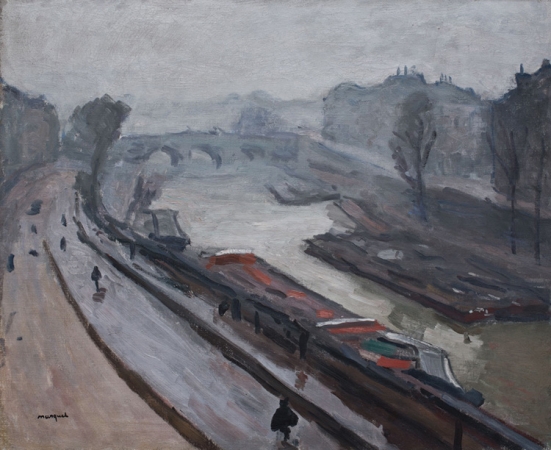MARQUET, Quai des Grands-Augustins

Albert MARQUET (1875-1947)
Quai des Grands-Augustins
1905-1906
oil on canvas
60 x 73 cm
© MuMa Le Havre / David Fogel
Quai des Grands-Augustins
1905-1906
oil on canvas
60 x 73 cm
© MuMa Le Havre / David Fogel
HD image
podcast
In 1905, Albert Marquet and his parents moved to 25, Quai des Grands-Augustins, located on the right bank of the Seine between the Pont Saint-Michel and the Pont-Neuf, barely visible here in the distance, shrouded in fog. Marquet observed the movements of the city, a dark silhouette with its shadow hurrying behind, the procession of barges, the furtive carriages.
In Quai des Grands-Augustins, the fog erases the details, leaving nothing but the lines of the quays, the contour of the monuments, in a harmony of muted greys broken only by the touches of vermilion on the docked barge. Matisse, evoking memories of his youth with his friend Marquet, remembers the difficulties he encountered: "Marquet did not have enough money to buy colours, especially the cadmiums, which were expensive. Consequently he painted in greys and perhaps this economic condition favoured his style."
It is not the burst of colour as one can see in the works of Matisse or Derain that makes Marquet a Fauve painter, but this simplification of form through large blocks of subdued halftones of colour. Did the painter use these shades due to lack of means or by choice? In July 1936, in a letter to his wife who was visiting her family in Provence, Marquet, who had stayed in Paris, wrote: "The weather is still beautiful, too beautiful, it is rather monotonous and I am eager to see a little grey."
While the dull tones prevail in his series of Parisian paintings, the colours are vibrant when Marquet turns his attention to the Mediterranean coast. An avid traveller, he loved Paris and always returned to paint on the banks of the Seine from wide plunging perspectives, reducing the portion of sky to depict urban life with the greatest precision, particularly in the Pont-Neuf series in the 1930s.
In Quai des Grands-Augustins, the fog erases the details, leaving nothing but the lines of the quays, the contour of the monuments, in a harmony of muted greys broken only by the touches of vermilion on the docked barge. Matisse, evoking memories of his youth with his friend Marquet, remembers the difficulties he encountered: "Marquet did not have enough money to buy colours, especially the cadmiums, which were expensive. Consequently he painted in greys and perhaps this economic condition favoured his style."
It is not the burst of colour as one can see in the works of Matisse or Derain that makes Marquet a Fauve painter, but this simplification of form through large blocks of subdued halftones of colour. Did the painter use these shades due to lack of means or by choice? In July 1936, in a letter to his wife who was visiting her family in Provence, Marquet, who had stayed in Paris, wrote: "The weather is still beautiful, too beautiful, it is rather monotonous and I am eager to see a little grey."
While the dull tones prevail in his series of Parisian paintings, the colours are vibrant when Marquet turns his attention to the Mediterranean coast. An avid traveller, he loved Paris and always returned to paint on the banks of the Seine from wide plunging perspectives, reducing the portion of sky to depict urban life with the greatest precision, particularly in the Pont-Neuf series in the 1930s.













